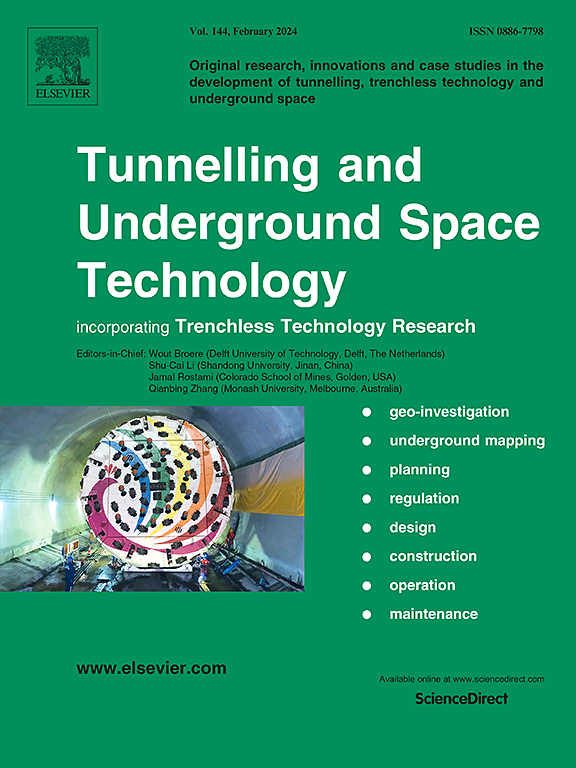A simplified analytical framework and solution for obliquely incident seismic waves on non-circular tunnel considering soil-tunnel interface effects
IF 7.4
1区 工程技术
Q1 CONSTRUCTION & BUILDING TECHNOLOGY
引用次数: 0
Abstract
This study presents an analytical framework to evaluate the seismic response of non-circular tunnel subjected to obliquely Incident Shear Vertical (ISV) waves, considering variations in the stiffness of surrounding ground medium (), angle of incidence (), soil-tunnel interface conditions (modeled via a slippage coefficient spanning no-slip to full-slip), and lining thickness. The pseudo-static formulation assumes that seismic wavelengths are much larger than the tunnel dimensions and employs conformal mapping to transform the irregular tunnel geometry into an equivalent circular domain. The proposed solution is validated against existing results for both circular and non-circular tunnels. A key contribution of this work is a novel representation of three-dimensional time-history representations for hoop stress and circumferential displacement that capture the spatiotemporal evolution of the tunnel response. Unlike conventional approaches that rely on peak ground acceleration (PGA), our results show that the peak structural response is phase-shifted and aligns more closely with the ground velocity. The analysis extracts absolute global maxima (maximum of maximum) along with their angular positions (), offering design-relevant insights that are not offered in various earlier methods reported in the literature. A systematic investigation of various factors reveals that increasing wave obliquity causes stress and displacement zones to shift along the tunnel perimeter. Higher reduces the deformation but may intensify stress due to reflection effects, while a greater leads to stress reduction and displacement amplification. Furthermore, this study shows that the lining thickness significantly influences response in soft ground, with thicker linings increasing the stress but reducing deformation. The current framework offers a practical, viable, and efficient tool for early-stage seismic design, capturing both critical response magnitudes and their spatial distribution under seismic loading conditions.
考虑土-隧道界面效应的非圆形隧道斜入射地震波简化分析框架及求解
本研究提出了一个分析框架来评估非圆形隧道在斜入射剪切垂直波(ISV)作用下的地震响应,考虑了周围地面介质刚度(Eg)、入射角(α)、土-隧道界面条件(通过跨越无滑移至全滑移的滑移系数δ建模)和衬砌厚度的变化。拟静力公式假设地震波长远大于隧道尺寸,并采用保角映射将不规则的隧道几何形状转换为等效的圆形区域。针对圆形和非圆形隧道的现有结果验证了所提出的解决方案。这项工作的一个关键贡献是一种新颖的三维时程表示,用于捕获隧道响应的时空演变的环向应力和周向位移。与依赖于峰值地面加速度(PGA)的传统方法不同,我们的研究结果表明,峰值结构响应是相移的,并且与地面速度更接近。该分析提取了绝对全局最大值(最大值的最大值)以及它们的角位置(θmax),提供了在文献中报道的各种早期方法中未提供的与设计相关的见解。对各种因素的系统研究表明,波浪倾角的增加导致应力和位移带沿隧道周长移动。较高的δ会使变形减小,但由于反射效应会使应力加剧,而较大的δ会使应力减小和位移放大。此外,研究表明,衬砌厚度对软土地基响应有显著影响,衬砌厚度增加了应力,但减小了变形。目前的框架为早期地震设计提供了一个实用、可行和有效的工具,可以捕获地震荷载条件下的临界响应震级及其空间分布。
本文章由计算机程序翻译,如有差异,请以英文原文为准。
求助全文
约1分钟内获得全文
求助全文
来源期刊

Tunnelling and Underground Space Technology
工程技术-工程:土木
CiteScore
11.90
自引率
18.80%
发文量
454
审稿时长
10.8 months
期刊介绍:
Tunnelling and Underground Space Technology is an international journal which publishes authoritative articles encompassing the development of innovative uses of underground space and the results of high quality research into improved, more cost-effective techniques for the planning, geo-investigation, design, construction, operation and maintenance of underground and earth-sheltered structures. The journal provides an effective vehicle for the improved worldwide exchange of information on developments in underground technology - and the experience gained from its use - and is strongly committed to publishing papers on the interdisciplinary aspects of creating, planning, and regulating underground space.
 求助内容:
求助内容: 应助结果提醒方式:
应助结果提醒方式:


